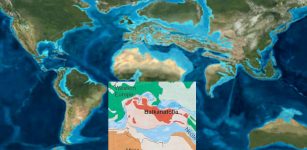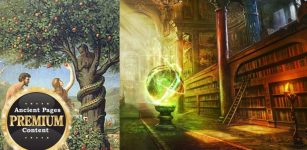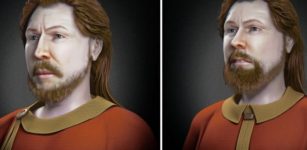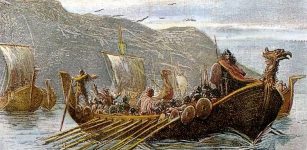Food And Clothing Of Middle Class Of The Sumerian Society
A. Sutherland - AncientPages.com - Many ancient cultures left their traces in Mesopotamia and these cultures had very much in common. They cultivated the same kinds of crops and had the same domestic animals. They also ate very similar food.
At first, meals were important in order to survive, and satisfy hunger, later, food was also consumed for enjoyment. Evening meals were usually taken before sunset; later, one could enjoy some entertainment. The poorest people like peasants ended their day with an evening meal only.
After a night usually spent on a reed mattress inside the house or on the house’s open second story (if the weather was warm), a middle-class Sumerian (a 'mushkinu') began his new day as a farmer, tailor, stonemason, potter or brewer.
Traditionally, each day started with morning prayers followed by breakfast, which for a ‘'mushkinu' contained barley flatbread along with some honey. The Sumerian diet usually varied depending on people's resources.
Hygiene was not any problem for the Sumerians or other Mesopotamian cultures. Most people had soap and water, and oils for personal hygiene. Both women and men combed and styled their hair. Men were also expected to comb and style their beards, and women were often expected to wear a head covering. The women braided their long hair, while the men had long hair and beards. Both men and women wore makeup.
Clothing for both sexes consisted of a kilt-like skirt (women wore long dresses), sandals, a wool tunic (sheepskin was also popular), and distinctive jewelry, especially rings. Then it was time to go to work.
Breakfast, lunch and evening meals
Common food for the ordinary Sumerian’s evening meal consists of fish mixed with cucumber, onions, apples, cheese, watercress, mustard, turnips and eggs. The diet of wealthier people was much more varied and enriched with beef, pork, birds, wild gazelle and wild fowl from the river.

According to other Mesopotamian cuneiform tablets, more than 50 different kinds of fish were an important addition to the Sumerian meals. Image source: Living in Ancient Mesopotamia
Additionally, hunters provided wild boar and venison; milk, butter, and cheese came from cattle, goats, and sheep. Fish was sold by many fish sellers and even restaurants offered ready-cooked meals with fish.
See also:
Oldest Evidence Of Beer Was Found On A Sumerian Tablet In Mesopotamia
What Did Houses For Ordinary People In Sumer Look Like?
The lesser Sumerian meals of the day such as breakfast and lunch were based on many of these products, additionally accompanied by a great variety of vegetables.
Meals after a hard day of work could contain a grain cake cooked with diverse fruit, along with dried fish and a pitcher of beer.
Recently deciphered Akkadian cuneiform tablets dated to 1900 BC, revealed a list of more than 800 different food items, 20 different kinds of cheese, 300 different breads, and 100 kinds of soup.
According to other Mesopotamian cuneiform tablets, more than 50 different kinds of fish were an important addition to the Sumerian meals. Also, spices and diverse vegetables and fruits, as well as grains and legumes, complemented the Sumerian diet perfectly. However, one of the most important and widely respected ingredients was honey - the only natural sweetener added to food on a daily basis.
Honey was also used in religious ceremonies and poured over shrine thresholds and stones as a commemorative offering, and door bolts of sacred buildings were anointed with a mixture of honey and wine.
People liked beer
Honey was also used in making beer. The oldest evidence of beer is believed to be a 6,000-year-old Sumerian tablet depicting people drinking a beverage through reed straws from a communal bowl. In Mesopotamia (ancient Iraq), there is early evidence of beer in form of a 3,900-year-old Sumerian poem honoring Ninkasi, the patron goddess of brewing, which contains the oldest surviving beer recipe, describing the production of beer from barley via bread. Archaeologists have unearthed ceramic vessels from 3400 BC still sticky with beer residue.
Babylonians who were an ancient post-Sumer civilization were brewing at least 20 different varieties of beer by 2000 BC
Wine, on the other hand, was rather expensive and therefore restricted to the wealthy people. The main beverages were beer, wine, and water, but poor people only had access to water taken from the rivers. It was kept in long-spouted kettles that could filter out the muddy sediment and make it drinkable.
Written by – A. Sutherland - AncientPages.com Senior Staff Writer
Copyright © AncientPages.com All rights reserved. This material may not be published, broadcast, rewritten or redistributed in whole or part without the express written permission of AncientPages.com
Expand for referencesReferences:
Hunter N. Daily Life in Ancient Sumer
Bertman S. Handbook to Life in Ancient Mesopotamia
More From Ancient Pages
-
 Balkanatolia: Existence Of A Long-Forgotten Continent Discovered
Archaeology | Mar 1, 2022
Balkanatolia: Existence Of A Long-Forgotten Continent Discovered
Archaeology | Mar 1, 2022 -
 Ancient Tombs Of The Nobles In The Valley Of The Queens
Featured Stories | Oct 23, 2016
Ancient Tombs Of The Nobles In The Valley Of The Queens
Featured Stories | Oct 23, 2016 -
 On This Day In History: Battle of Devil’s Hole Was Fought – On Sep 14, 1763
News | Sep 14, 2016
On This Day In History: Battle of Devil’s Hole Was Fought – On Sep 14, 1763
News | Sep 14, 2016 -
 66 Diorite Statues Of Lion-Headed Goddess Sekhmet Discovered In Luxor, Egypt
Archaeology | Mar 9, 2017
66 Diorite Statues Of Lion-Headed Goddess Sekhmet Discovered In Luxor, Egypt
Archaeology | Mar 9, 2017 -
 Why Is La Ferrassie Man A Unique And Famous Neanderthal?
Featured Stories | Oct 30, 2023
Why Is La Ferrassie Man A Unique And Famous Neanderthal?
Featured Stories | Oct 30, 2023 -
 Was The Tree Of Knowledge Perhaps The Hall Of Records? – A Mysterious Ancient Library Containing Forbidden Knowledge
Ancient Mysteries | Mar 29, 2017
Was The Tree Of Knowledge Perhaps The Hall Of Records? – A Mysterious Ancient Library Containing Forbidden Knowledge
Ancient Mysteries | Mar 29, 2017 -
 Rare Discovery: Giant Stone Artifacts Found On Ice Age Site In Kent
Archaeology | Jul 6, 2023
Rare Discovery: Giant Stone Artifacts Found On Ice Age Site In Kent
Archaeology | Jul 6, 2023 -
 New York’s Queen Of Thieves Fredericka Mandelbaum Opened Marm’s Grand Street School For Criminals
Featured Stories | Jul 24, 2024
New York’s Queen Of Thieves Fredericka Mandelbaum Opened Marm’s Grand Street School For Criminals
Featured Stories | Jul 24, 2024 -
 Etzanoa: Long-Lost Native American City Discovered In Kansas After 400 Years
Archaeology | Apr 24, 2017
Etzanoa: Long-Lost Native American City Discovered In Kansas After 400 Years
Archaeology | Apr 24, 2017 -
 Collapse Of Ancient Mayan Capital Linked To Drought – New Study Suggests
Archaeology | Aug 20, 2022
Collapse Of Ancient Mayan Capital Linked To Drought – New Study Suggests
Archaeology | Aug 20, 2022 -
 Cartography Shows That The Isthmus Of Tehuantepec Was Used As An Inter-Oceanic Passage In The 16th Century
Archaeology | Oct 21, 2022
Cartography Shows That The Isthmus Of Tehuantepec Was Used As An Inter-Oceanic Passage In The 16th Century
Archaeology | Oct 21, 2022 -
 Mysterious Ancient Female Society Discovered – What Happened To All The Men? Archaeologists Wonder
Featured Stories | Oct 3, 2024
Mysterious Ancient Female Society Discovered – What Happened To All The Men? Archaeologists Wonder
Featured Stories | Oct 3, 2024 -
 Mythical Place Where Gorgon Medusa Dwelled And Was Killed May Have Been Found By Archaeologists
Featured Stories | Sep 15, 2024
Mythical Place Where Gorgon Medusa Dwelled And Was Killed May Have Been Found By Archaeologists
Featured Stories | Sep 15, 2024 -
 Colors On These Ancient Pots Hint At The Power Of An Empire
Archaeology | Mar 7, 2023
Colors On These Ancient Pots Hint At The Power Of An Empire
Archaeology | Mar 7, 2023 -
 Mysterious Ancient Mayan ‘Copernicus’ And The Venus Table Of The Dresden Codex: The Hieroglyphs Have Been Misunderstood – Researcher Says
Archaeology | Aug 23, 2016
Mysterious Ancient Mayan ‘Copernicus’ And The Venus Table Of The Dresden Codex: The Hieroglyphs Have Been Misunderstood – Researcher Says
Archaeology | Aug 23, 2016 -
 Adaptable And Flexible Neanderthals May Have Inhabited Danish Island 120,000 Years Ago
Archaeology | Oct 25, 2020
Adaptable And Flexible Neanderthals May Have Inhabited Danish Island 120,000 Years Ago
Archaeology | Oct 25, 2020 -
 3,300-Year-Old Mycenaean-Like Seal And Dagger Discovered In Turkey
Archaeology | Jul 22, 2022
3,300-Year-Old Mycenaean-Like Seal And Dagger Discovered In Turkey
Archaeology | Jul 22, 2022 -
 Kikimora – Nightly Evil Female Spirit And Goddess Of Chickens In Slavic Beliefs
Featured Stories | Oct 22, 2018
Kikimora – Nightly Evil Female Spirit And Goddess Of Chickens In Slavic Beliefs
Featured Stories | Oct 22, 2018 -
 Stunning Facial Reconstruction Of Saint Ludmila’s Sons Of The Czech Royal Premyslid Dynasty
Archaeology | Mar 8, 2021
Stunning Facial Reconstruction Of Saint Ludmila’s Sons Of The Czech Royal Premyslid Dynasty
Archaeology | Mar 8, 2021 -
 Norse Kingdom Of Dublin Was Founded By The Vikings In 839 A.D.
Ancient History Facts | Mar 15, 2016
Norse Kingdom Of Dublin Was Founded By The Vikings In 839 A.D.
Ancient History Facts | Mar 15, 2016

